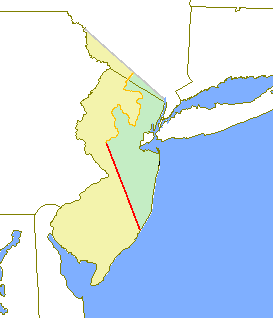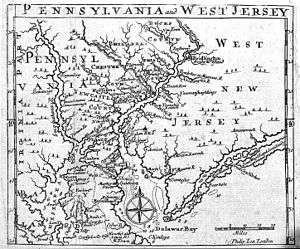West Jersey
West Jersey and East Jersey were two distinct parts of the Province of New Jersey. The political division existed for 28 years, between 1674 and 1702. Determination of an exact location for a border between West Jersey and East Jersey was often a matter of dispute.
Province of West Jersey | |||||||||
|---|---|---|---|---|---|---|---|---|---|
| 1674–1702 | |||||||||
| Status | Colony of England | ||||||||
| Capital | Burlington | ||||||||
| Common languages | English | ||||||||
| Government | Constitutional monarchy | ||||||||
| History | |||||||||
• Established | 1674 | ||||||||
• Disestablished | 1702 | ||||||||
| Currency | Pound sterling | ||||||||
| |||||||||
| Today part of | |||||||||


Background
The Delaware Valley had been inhabited by the Lenape (or Delaware) Indians prior to European exploration and settlement starting around 1609, undertaken by the Dutch, Swedish and English. The Dutch West India Company had established one or two Delaware River settlements but by the late 1620s, it had moved most of their inhabitants to the island of Manhattan. This became the center of New Netherland.[1] West Jersey and East Jersey were two sections of New Jersey
The development of the colony of New Sweden in the lower Delaware Valley began in 1638. Most of the Swedish population was on the west side of the Delaware. After the English re-established New Netherland's Fort Nassau to challenge the Swedes, the latter constructed Fort Nya Elfsborg in present-day Salem County. Fort Nya Elfsborg was located between present day Salem and Alloway Creek. The New Sweden colony established two primary settlements in New Jersey: Sveaborg, now Swedesboro, and Nya Stockholm, now Bridgeport. Trinity Church, located in Swedesboro, was the site of the Church of Sweden for the area.[2][3]
The Dutch defeated New Sweden in 1655. Settlement of the West Jersey area by Europeans was thin until the English conquest in 1664. Beginning in the late 1670s, Quakers settled in great numbers in this area, first in present-day Salem County and then in Burlington. The latter became the capital of West Jersey.[4]
Before 1674, land surveyors for New Jersey considered it as a hundred and partitioned it into Tenths. West Jersey comprised five of the Tenths. But demarcation of the boundaries awaited settlement, the quit-rents the settlers would pay, and the land surveying which the money would purchase. Thus it took years and multiple surveys to settle boundary disputes. Burlington County was formed on 17 May 1694 by combining "the first and second Tenths."[5] At least three expensive surveys were conducted of West Jersey. Richard Tindall was surveyor-general of Fenwick's Colony, the fifth Tenth.
| Date | Boundary Name | Description |
| 1674 | Original Duke of York Line
(did not recognize John Fenwick’s holdings) |
Barnegat Bay to Rancocas Creek on the Delaware River just north of present-day Philadelphia. |
| 1676 | Quintipartite Deed Line
(between George Carteret on the East, and William Penn, Gawen Lawrie, Nicholas Lucas, and Edward Byllynge on the West, except for 10% to John Fenwick)
|
On the north from a point 11deg 40' latitude on the Delaware River extending southward on a straight and direct line to the east side of Little Egg-Harbor. |
| 1687 | William Emley / John Reid Adjustment (commissioners from West and East Jersey respectively) | Adjusted description on the Delaware fifty minutes more westerly due to magnetic compass variation |
| 1687 | Keith Line aka Province Line
(Surveyed north only to the south branch of the Raritan River) |
Stopped by Governor Daniel Coxe of West Jersey and Governor Robert Barclay of East Jersey |
| 1688 | Coxe-Barclay Line Survey | Extended the Keith Line from the Raritan River along specific properties that defined the eastern boundaries of present- day Morris and Sussex Counties and the northern border of Somerset County |
| 1696 | Thornton Line Survey | Attempted to correct errors from previous surveys |
| 1702 | East and West Jersey United | Violence became so obsessive, that East and West proprietors gave up their individual governing rights to Queen Anne |
| 1743 | Lawrence Line Survey
(Land ownership disputes continued. West Jersey proprietors attempted to fund survey but failed. East Jersey Proprietors then hired John Lawrence) |
Adopted by NJ supreme court in 1855 as the final arbiter of all land disputes. Today defines boundary for Walpack, Sandyston, Stillwater, Hampton, and Green Townships |
Constitution
See also
Other sources
- Weslager, C. A. Dutch Explorers, Traders, and Settlers in the Delaware Valley, 1609–1644. (Philadelphia, University of Pennsylvania Press, 1961).
- Johnson, Amandus The Swedish Settlements on the Delaware Volume I: Their History and Relation to the Indians, Dutch and English, 1638–1664 (Philadelphia: Swedish Colonial Society. 1911)
References
- The Delaware Indians: A History, (by Weslager, C. A. New Brunswick, NJ: Rutgers University Press. 1972)
- The Swedes and Finns in New Jersey (Federal Writers' Projectejjejjdejje of WPA. Bayonne, New Jersey: Jersey Printing Company, Inc. 1938)
- A Brief History Of The Early Swedes in New Jersey (Gloucester County NJ History and Genealogy) http://www.nj.searchroots.com/Gloucesterco/swedesboro.htm
- British Colony (Burlington County Historical Society. Burlington City, NJ )
- Snyder, John P. The Story of New Jersey's Civil Boundaries: 1606–1968, Bureau of Geology and Topography; Trenton, New Jersey; 1969. p. 93. Accessed September 30, 2013.
External links
- West Jersey History Project
- Quaker West New Jersey: Democracy in 1677
- 1677 Charter
- 1681 Regulations
- Where was the West Jersey/East Jersey line?
- Colonial Charters, Grants and Related Documents (at "New Jersey"). The Avalon Project: Documents in Law, History and Diplomacy. Lillian Goldman Law Library (Yale Law School). Retrieved 2010-03-14.